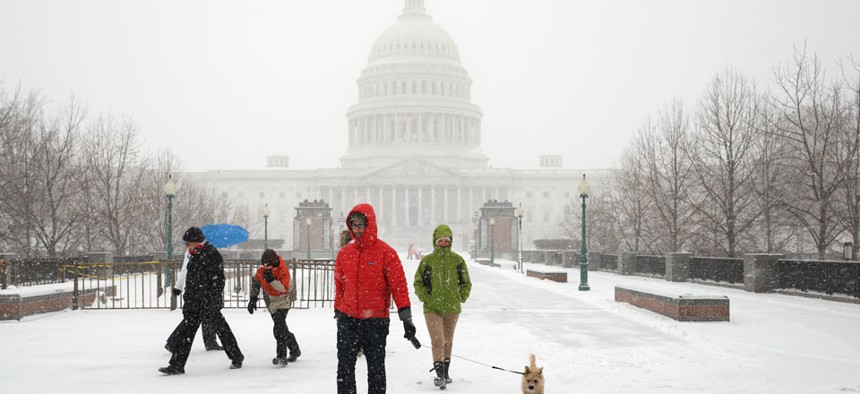The Death of the Federal Snow Day?

J. Scott Applewhite/AP
'This really isn’t just about teleworking anymore,' Tangherlini says.
Mobile work is dramatically changing the federal workplace – effectively moving some federal offices from a place where employees go to work to a place where they go to share ideas.
That was the theme of Mobile Work Exchange’s spring Town Hall Meeting in April, where the General Services Administration and other agencies talked about a workplace transformation that brings together concepts like telework, human resources, facilities management and information technology to improve employee engagement and collaboration and also reduce agency spending in areas such as real estate.
For GSA, which earlier this year unveiled its 1800 F headquarters building that features open, collaborative workspace, the total workplace transformation has not only positioned the agency as a more appealing place to work among young employee recruits, it also has led to the death of the federal snow day, GSA Administrator Dan Tangherlini told the audience at the town hall meeting.
For example, the Snowmageddon snowstorm that hit the Mid-Atlantic region on Feb. 9, 2010 resulted in 22,138 hours of administrative leave taken among employees, with only 673 total hours teleworked by employees. The most recent federal snow day, March 17, 2014, however, resulted in just 2,738 hours of administrative leave taken, with employees logging 13,296 hours of telework, he said. That equated to 96 percent of employees teleworking on the snow day, with just 4 percent taking leave, he said.
“We made the critical services available to people where they are, when they need it so they can work regardless if they can get to work,” he said.
Still, it’s no longer just about telework but rather a dramatic shift in the way employees, managers and leadership define work, Tangherlini said. Now, he and two other high-level GSA officials sit just 40 feet from each other, where previously they worked in three different buildings miles away. “It’s about that unexpected, unscheduled conversation and breaking down the barriers of hierarchy to reduce inefficiency in the organization,” he said.
Other agencies have since reached out to GSA for help in adopting a more open, collaborative workspace. The Agriculture Department, for example, is looking to reduce its 43 state offices to 12 regional locations, while agencies like the Health and Human Services and Homeland Security departments and the Fish and Wildlife Service are looking to save millions by embracing technology and reducing their real estate footprints, he said.
“This really isn’t just about teleworking anymore,” Tangherlini said. “This is about mobile working, freeing our data, democratizing our space and making ourselves dramatically more efficient, whether we’re on the road, collaborating in the office or working at home because it snowed again or because that’s where we can be most productive and efficient.”
NEXT STORY: A Magic 8 Ball, Armed With Data






